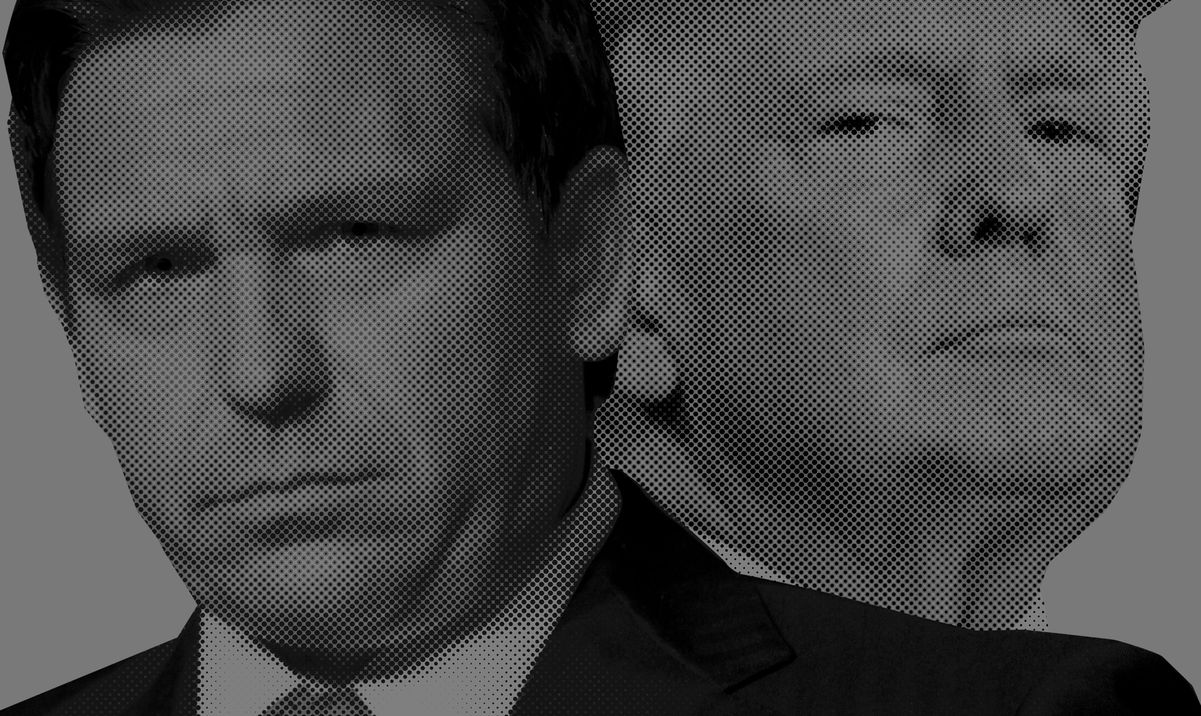| As a rule, State of the Union addresses are what Daniel Boorstin has called pseudo-events: scripted affairs whose only news value is the commentary surrounding them. But President Biden’s speech gave some important signals about the upcoming election. Biden is probably going to run — his performance was lively enough to at least slightly alleviate doubts about his age — and his campaign is likely to focus on a defense of Medicare, Medicaid, and Social Security. |
| This dynamic clicked into place for me when I saw two pieces of reporting about Ron DeSantis, the conservative Establishment’s selection to replace Donald Trump as the presidential nominee. First, Josh Barro noted that, as a member of the House in 2013 and 2014, DeSantis not only voted for Paul Ryan’s plan to turn Medicare into vouchers but also supported an even more radical plan that “would have raised the retirement ages for both Social Security and Medicare to 70, cut the growth rate of Social Security benefits, and changed Medicare from a program that guarantees access to health insurance into one that would have provided a stipend payment that would not, over time, have necessarily kept pace with the actual cost to buy health insurance.” |
| The next day, Andrew Kaczynski and Em Steck reported for CNN that DeSantis had endorsed privatizing both Medicare and Social Security. “I would embrace proposals like [Rep.] Paul Ryan offered, and other people have offered, that are going to provide some market forces in there, more consumer choice, and make it so that it’s not just basically a system that’s just going to be bankrupt when you have new people coming into it,” DeSantis said in a video CNN dug up. “Social Security, I would do the same thing.” |
 | ![]() | | Photo-Illustration: Intelligencer; Photos: Getty Images | | | | What is perhaps even more telling is the response from DeSantis: nothing. |
| DeSantis has built an identity as a fearless pugilist. One of his ads literally boasts that DeSantis will “never, ever back down from a fight.” And yet, even after the media reported these damaging stories, and even after Biden traveled to Florida to give a speech attacking him for denying health coverage to a million Floridians by boycotting Medicaid expansion, DeSantis did not reply. |
| DeSantis’s peripatetic spokespeople — both official (Christina Pushaw, Jeremy Redfern) and unofficial (Chris Rufo, Karol Markowicz, David Reaboi, to name a handful among a cast of thousands) — normally swarm over any reporter who paints the boss in an unflattering light. As of Monday morning, they have tweeted absolutely nothing about this. |
| The absolute silence from DeSantis World on this issue reveals that he understands perfectly well that his history of endorsing right-wing views on the welfare state poses a serious vulnerability. It will be fascinating to see how DeSantis handles this vulnerability going forward. Maybe he will renounce his old views. Or maybe he thinks he can continue to focus exclusively on his own preferred issues and win enough voters solely through a bubble curated by media loyal to him. |
| You’ve probably read plenty about illiberal excesses in progressive spaces. It’s difficult to find one that more effectively exposes the absurdity of these contemporary norms than the story of how a Macalester College art exhibit was briefly closed owing to student complaints, then reopened with curtains and frosted glass to hide the offensive content from innocent eyes. |
| Here is the funny part. The exhibit was deemed offensive not despite but because it expressed feminist protest against religious puritanism. |
| Now why, you may ask, would progressive students object to an art exhibit critiquing misogyny? Well, the exhibit was critiquing Islamist misogyny: |
| A woman in a niqab shows her leg and crotch and gives the viewer the finger; a woman in a hijab pulls up her dress to show the sexy lingerie underneath. Several sculptures depict women in niqabs fully covered except for cartoonishly large protruding breasts. |
| |
| If the protesters had deemed the exhibit blasphemous, or arousing, or said it celebrated women as whores, the exhibit would have stood firm against reactionary philistinism. Instead, they cleverly couched their complaint in social-justice lingo. “The decision to display and continue to display this exhibition despite the harm it perpetuates is a deeply problematic issue. It is targeting and harming an already small community that exists on this campus,” complains the petition. |
| The complaining students believed that if they presented supporters of strict Islamic fundamentalism as an oppressed minority, the museum would ignore the content of their objection. And they were right! What this shows, of course, is how easy it is to hack into and manipulate norms that assume any person deemed to be from an oppressed class can decide any idea they don’t like is “harmful.” |
| Jill Filipovic, through whom I found this story, has an excellent commentary on it. “If you can’t handle seeing breasts — including breasts on a woman who wears a hijab or niqab — I would recommend not going to any art museum or exhibit,” she writes, “I might stay off of the internet, too, and perhaps reconsider leaving the house.” |
| Her broader point strikes me as clearly true: “Leaning into the language of ‘harm’ creates and reinforces feelings of harm, and while using that language may give a person some short-term power in progressive spaces, it’s pretty bad for most people’s long-term ability to regulate their emotions, to manage inevitable adversity, and to navigate a complicated world.” |
| It is very easy for liberals to see this when the idea of “harm” is derived from religious fundamentalism. We understand perfectly well that creating taboos around images, thoughts, and words are ways of controlling ideas and this control is merely justified by appeals to preventing harm to onlookers. The challenge is to extend this easy clarity to social taboos derived from belief systems closer to home. |
 | ![]() | | Photo-Illustration: Intelligencer; Photo: Getty Images | | | | Kyrsten Sinema is a fascinating subject to me because she did something rare in the Democratic Party: She threw away her political career over a matter of principle, specifically bad principles. Sinema went to the mat to protect the super-wealthy from taxation and to severely limit the federal government’s ability to negotiate prescription-drug prices. |
| These policies have no meaningful electoral constituency. She forced herself into a position where, having little chance to win a Democratic primary, she fled the party and is running as an independent (assuming she makes it all the way to the election, which does not strike me as a certainty). |
| Tara Palmieri reports Sinema was recently being “fêted at a fundraiser in Palm Beach by Steve Schwarzman.” |
| Who is Steve Schwarzman? He’s a Republican hedge-funder and probably the heart of Sinema’s base. Schwarzman has backed various Republicans, but he does not care about social policy or racism. He is in it for the tax cuts. |
| In 2010, he compared President Obama’s plan to tax private-equity firms to Hitler’s invasion of Poland. This statement clarified that Schwarzman sees both progressive taxation and Nazism as evil. Which one he saw as more evil was an abstract question until we got a president who liked Nazis and hated taxing the rich, at which point Schwarzman became a major donor. |
| In the wake of the insurrection, when the business class was suddenly and briefly abandoning Trump, the Guardian reported on his prior support for Trump, and a Schwarzman spokesperson hilariously explained it was “purely about matters related to economic policy and trade, not politics.” It’s not that he’s immoral; he’s just amoral. |
| Arizona Democrats have been attacking Sinema as ignoring her constituents to cater instead to her superrich pals. This alliance is hardly going to dispel that line of attack. |
| Columbia sociologist Musa Al-Gharbi argues in a new column that the wave of illiberal norms sweeping through progressive institutions has already begun to recede. I made a similar argument a year ago. Al-Gharbi’s version has a handful of differences. He dates the origination of the trend to 2011, a few years before I do, and defines the locus as “knowledge economy” hubs. His column also brings to bear more data to measure the peaking of the trend: |
| Across a range of datasets, we see apparent declines in “grassroots” attempts to censor uncomfortable speech on campus (even as there are growing attempts to suppress political scholarship from external stakeholders) … |
| Companies are slackening their enforcement of post-2010 norms and expectations on identity issues. For instance, they are growing less likely to rapidly terminate or suspend employees accused of sexual misconduct based purely on the word of accusers. At the same time, they are walking back their aggressive symbolic commitments to social justice and quietly defunding the financial pledges they made to various activist groups and causes. Many are also making aggressive cuts to the DEI-related positions that ballooned in recent years. |
| |
| I find his case persuasive. I would like to highlight one factor that I have cited and that he omits. Al-Gharbi, like me, sees political outcomes as an important driver. Democrats recognized after the 2020 election that their left-wing activists were associating their party with unpopular policies and rhetoric and recognized the need for a course correction. |
| The factor he does not cite is Donald Trump receding from public attention. It is true that even before Trump ran for president, left-wingers had advanced reductive views about race and gender within progressive spaces. But Trump’s rise was gasoline on the fire. |
| As silly as it may sound, Trump’s overt sexism and racism has remained deeply underappreciated. On occasion, I’ve brought up Trump’s overtly racist rhetoric to conservatives, and they respond with blank stares. During the presidential campaign, Paul Ryan conceded that Trump’s claim that a “Mexican judge” was inherently biased was a “textbook definition of a racist statement.” |
| Trump never stopped making statements like this. As last week’s Twitter hearings revealed, he violated the site’s terms of service by telling people from immigrant communities to go back to “their” country. (Twitter responded by making an exception for him. When you’re a star, they let you do it.) |
| An ideology that claimed racism and sexism were endemic, and required totalistic and sometimes even cultlike behavior to eradicate, became much more persuasive when the president of the United States was running around calling women ugly and telling brown-skinned people they had no right to participate in public affairs. I don’t think it’s a coincidence that the wave of post-liberal progressivism has receded as Trump has exited the national stage. |
| Stay informed about business, politics, technology, and where they intersect. Subscribe now for unlimited access to Intelligencer and everything New York. |
| If you enjoyed reading &c. by Jonathan Chait, forward it to a friend. For more from Intelligencer, sign up for the daily newsletter or One Great Story to get a single editor-selected longread sent to you every weeknight. |
| | |




